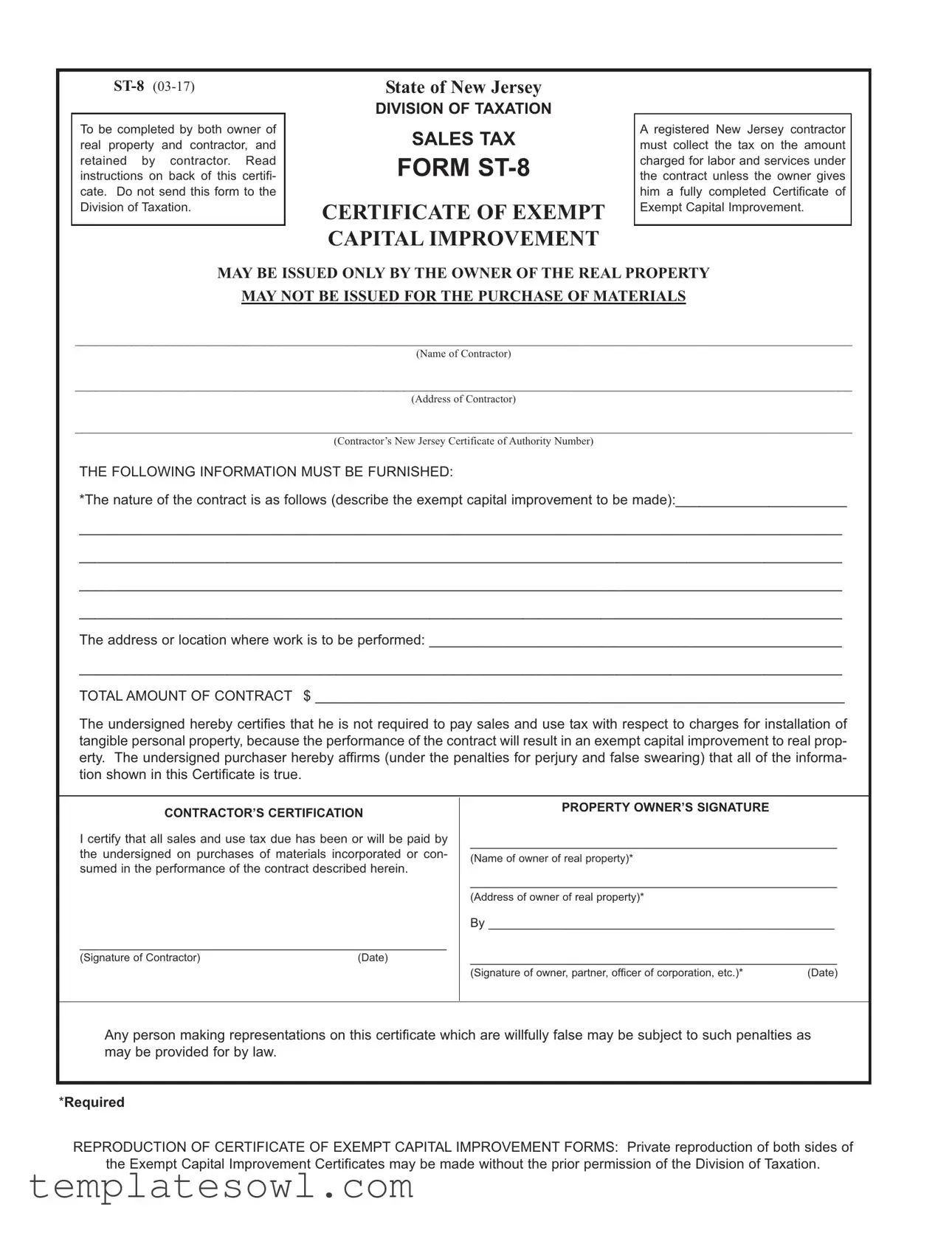-(03-17)
To be completed by both owner of real property and contractor, and retained by contractor. Read instructions on back of this certifi- cate. Do not send this form to the Division of Taxation.
w
DIVISION OF TAXATION
SALES TAX
FORM ST-8
A registered New Jersey contractor must collect the tax on the amount charged for labor and services under the contract unless the owner gives him a fully completed Certificate of Exempt Capital Improvement.
O
O
OOH
_______________________________________________________________________________________________________________
(Name of Contractor)
_______________________________________________________________________________________________________________
(Address of Contractor)
_______________________________________________________________________________________________________________
(Contractor’s New Jersey Certificate ofAuthority Number)
THE FOLLOWING INFORMATION MUST BE FURNISHED:
*The nature of the contract is as follows (describe the exempt capital improvement to be made):______________________
__________________________________________________________________________________________________
__________________________________________________________________________________________________
__________________________________________________________________________________________________
__________________________________________________________________________________________________
The address or location where work is to be performed: _____________________________________________________
__________________________________________________________________________________________________
TOTALAMOUNT OF CONTRACT $ ____________________________________________________________________
The undersigned hereby certifies that he is not required to pay sales and use tax with respect to charges for installation of tangiblepersonalproperty,becausetheperformanceofthecontractwillresultinanexemptcapitalimprovementtorealprop- erty. The undersigned purchaser hereby affirms (under the penalties for perjury and false swearing) that all of the informa- tion shown in this Certificate is true.
CONTRACTOR’S CERTIFICATION |
PROPERTY OWNER’S SIGNATURE |
|
|
|
I certify that all sales and use tax due has been or will be paid by |
_____________________________________________________ |
the undersigned on purchases of materials incorporated or con- |
(Name of owner of real property)* |
|
sumed in the performance of the contract described herein. |
|
|
|
|
_____________________________________________________ |
|
|
(Address of owner of real property)* |
|
|
|
By __________________________________________________ |
_____________________________________________________ |
|
|
(Signature of Contractor) |
(Date) |
_____________________________________________________ |
|
|
(Signature of owner, partner, officer of corporation, etc.)* |
(Date) |
|
|
|
|
Any person making representations on this certificate which are willfully false may be subject to such penalties as may be provided for by law.
*Required
REPRODUCTION OF CERTIFICATE OF EXEMPT CAPITAL IMPROVEMENT FORMS: Private reproduction of both sides of the Exempt Capital Improvement Certificates may be made without the prior permission of the Division of Taxation.
O
OOIn cases where the contractor performs work which results in an exempt capital improvement to your house or land (real property), he may NOT charge you any sales tax if you issue to him a fully completed Certificate of Exempt Capital Improvement (Form ST-8).
It is important to distinguish between an exempt capital improvement and a taxable capital improvement, repair or installation. If the fulfillment of a contract only maintains the existing value of the property, it is a repair and not a capital improvement. Where an improvement results in an increase in the capital value of the real property, it is generally considered that a capital improvement has been performed. (But see below list of taxable capital improvements.)
As an aid to determine whether a contract is for a repair to real property or a capital improvement to real property, the treatment of such transaction for income tax purposes under the Federal Internal Revenue Code may be used as a guide. If you have any doubt whether the work to be performed constitutes a repair or an exempt capital improvement, you should communicate with the Division of Taxation and describe in detail such work.
The following are examples of exemptcapital improvements: |
|
New construction (other than taxable |
Porch enclosure, construction of |
Paneling, installation of |
capital improvements listed below) |
New roof, installation of |
New heating system installation |
In-ground swim pool, installation of |
Tiled bath, installation of |
Rewiring |
New central air conditioner installation |
New bath fixtures, installation of |
New electrical outlets installed |
Painting a newly constructed house |
New kitchen cabinets, installation of |
New siding, installation of |
New hot water heater installation |
New kitchen fixtures, installation of |
Garage, construction of |
Patio, construction of |
Paving of driveway |
Storm doors and windows, original |
|
|
or initial installation of |
The following are examples of taxablecapital improvements. This form cannot be issued for these services, which are subject to sales tax on and after October 1, 2006:
Seeding, sodding, grass plugging of new lawns, planting trees, shrubs, hedges, plants, etc.
Clearing and filling land associated with seeding, sodding, grass plugging of new lawns, or planting trees, shrubs, hedges, plants, etc., including tree/stump removal
Installing carpeting and other flooring
Installing a hard-wired security, burglar or fire alarm system
OOO : If you enter into a contract to add to or improve real property by an exempt capital improvement (see examples above) and the property owner issues to you a properly completed Certificate of Exempt Capital Improvement, which you must retain, you should not collect sales tax from the property owner. (You are required to pay sales tax to your supplier on the purchase of the tangible personal property you purchase for use in performing the contract irrespective of whether the work constitutes a repair or a capital improvement.)
However, if you enter into a contract to repair, maintain, or service real or tangible personal property, or to install a taxable capital improvement, you must collect tax on the charge for labor or services performed in accordance with the contract.
Registered sellers who accept fully completed exemption certificates within 90 days subsequent to the date of sale are relievedof liability for the collection and payment of sales tax on the transactions covered by the exemption certificate. The following information must be obtained from a purchaser in order for the exemption certificate to be fully completed:
•Purchaser’s name and address;
•Type of business;
•Reasons(s) for exemption;
•Purchaser’s New Jersey tax identification number or, for a purchaser that is not registered in New Jersey, the Federal employer identification number or out-of-State registration number. Individual purchasers must include their driver’s license number;
•If a paper exemption certificate is used (including fax), the signature of the purchaser.
The seller’s name and address are not required and are not considered when determining if an exemption certificate is fully completed. Aseller that enters data elements from paper into an electronic format is not required to retain the paper exemption certificate.
The seller may, therefore, accept this certificate as a basis for exempting sales to the signatory purchaser and is relieved of liability even if it is determined that the purchaser improperly claimed the exemption. If it is determined that the purchaser improperly claimed an exemption, the purchaser will be held liable for the nonpayment of the tax.
c- Certificates must be retained by the seller for a period of not less than four years from the date of the last sale covered by the certificate. Certificates must be in the physical possession of the seller and available for inspection.
cccxc– On and after October 1, 2011, if the seller either has not obtained an exemption certificate or the seller has obtained an incomplete exemption certificate, the seller has at least 120 days after the Division’s request for substantiation of the claimed exemption to either:
1.Obtain a fully completed exemption certificate from the purchaser, taken in good faith, which, in an audit situation, means that the seller obtain a certificate claiming an exemption that:
(a)was statutorily available on the date of the transaction, and
(b)could be applicable to the item being purchased, and
(c)is reasonable for the purchaser’s type of business; OR
2.Obtain other information establishing that the transaction was not subject to the tax.
If the seller obtains this information, the seller is relieved of any liability for the tax on the transaction unless it is discovered through the audit process that the seller had knowledge or had reason to know at the time such information was provided that the information relating to the exemption claimed was materially false or the seller otherwise knowingly participated in activity intended to purposefully evade the tax that is properly due on the transaction. The burden is on the Division to establish that the seller had knowledge or had reason to know at the time the information was provided that the information was materially false.
OOOORead publication S&U-6 (Sales Tax ExemptionAdministration) at http://www.state.nj.us/treasury/taxation/pdf/pubs/sales/su6.pdf
O OOOOO
This form is to be completed by purchaser and given to and retained by seller

